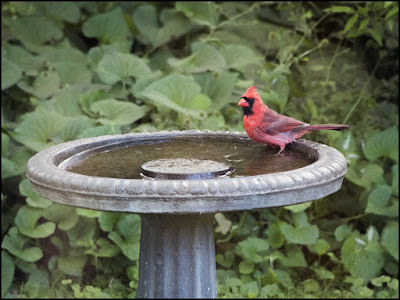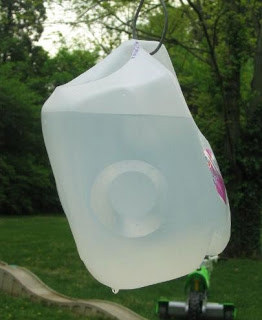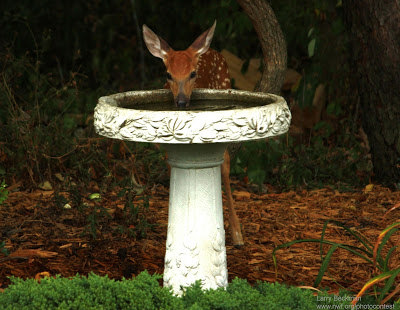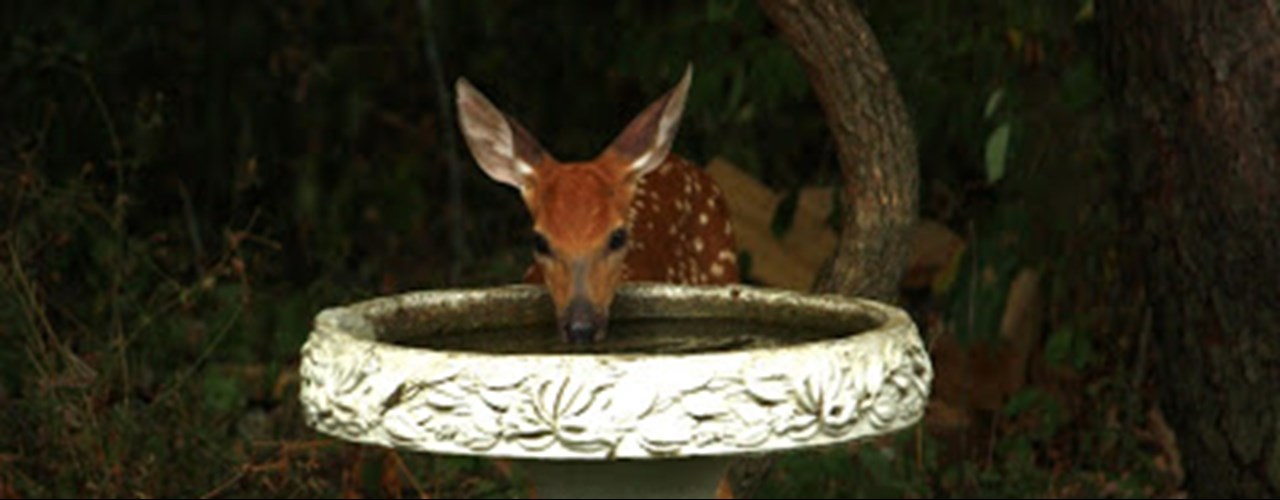Providing Water for Backyard Wildlife
When choosing a water feature to attract wildlife to your backyard, you can often feel like you are drowning in options – and not all the choices are equally suited to benefit wildlife. There are three main ways to provide free water (i.e., water that is not contained in plants) for wildlife in your yard: birdbaths, ponds, and dripping water features.
Birdbaths are one of the most popular methods of providing water to wildlife. To provide birds with a resource that is helpful rather than harmful, it is important to clean birdbaths frequently. If birdbaths are not cleaned regularly, especially during the summer, they can accumulate bird droppings, grow algae, and create an ideal spot for mosquitoes to lay their eggs in the stagnant water. Dirty birdbaths can become a source of disease transfer, which can be detrimental to the health of the birds that visit your yard. In winter, birds need less water than in the summer, but it is a good idea to continue to fill your bird bath every day, to guarantee you have feathered visitors all year long.
The best birdbaths mimic nature. Store-bought birdbaths often are too deep for small birds or have a glazed surface that is slippery and hard for birds to grip. A good birdbath imitates a shallow pool of water with gradually sloping edges and plenty of texture on the bottom. Aim to have no more than 2 inches of water in the middle of the birdbath and between 0.5 - 1 inch at the edges. Place stones or branches in and around your birdbath so small birds can also access the water. The location of your birdbath is also an important factor. Birdbaths in the shade are cooler, stay fresh longer, and will create the ideal space for birds (and maybe other animals) looking to relax. Close proximity to trees and shrubs will create shade and tree branches provide excellent spots for birds to rest and preen.

This birdbath is not too slippery or deep and has a stone in the middle on which birds can comfortably stand. Photo by Gene Wilburn.

in an old milk carton and hanging it above your birdbath.

Keep in mind that providing supplemental water for wildlife comes with the responsibility to manage that resource. Water will attract many types of animals to your yard, which may include nuisance species such as squirrels. Carefully choosing your backyard water sources can often determine which wildlife species will most likely appear, but nature can be unpredictable. If you decide to incorporate water for wildlife in your backyard, be prepared to see something new every day!
Literature Cited
- Attract Birds with Birdbaths. 2009. The Cornell Lab of Ornithology All About Birds. Web. https://www.allaboutbirds.org/attract-birds-with-birdbaths/
- Backyard Habitat for our Native Songbirds. Featherhaven. Web. http://www.featherhaven.org/backyard-tips.html
- Feeding Wildlife. 2017. Iowa State University Wildlife Extension and Outreach. Web. https://www.nrem.iastate.edu/wildlife/feeding-wildlife
- Russo, Monica. How to Make a Birdbath. 2015. National Audubon Society. Web. http://www.audubon.org/news/how-make-birdbath
- Top 25 Feeder Birds 2016-17 Texas. 2017. The Cornell Lab of Ornithology Project FeederWatch. Web. http://feederwatch.org/pfw/top25/PFW_2017/US-TX
- Water for Wildlife: Bird Baths and Backyard Ponds. 2017. Penn State Extension. Web. https://extension.psu.edu/water-for-wildlife-bird-baths-and-backyard-ponds
--
Edited by Maureen Frank, Extension Wildlife Specialist




